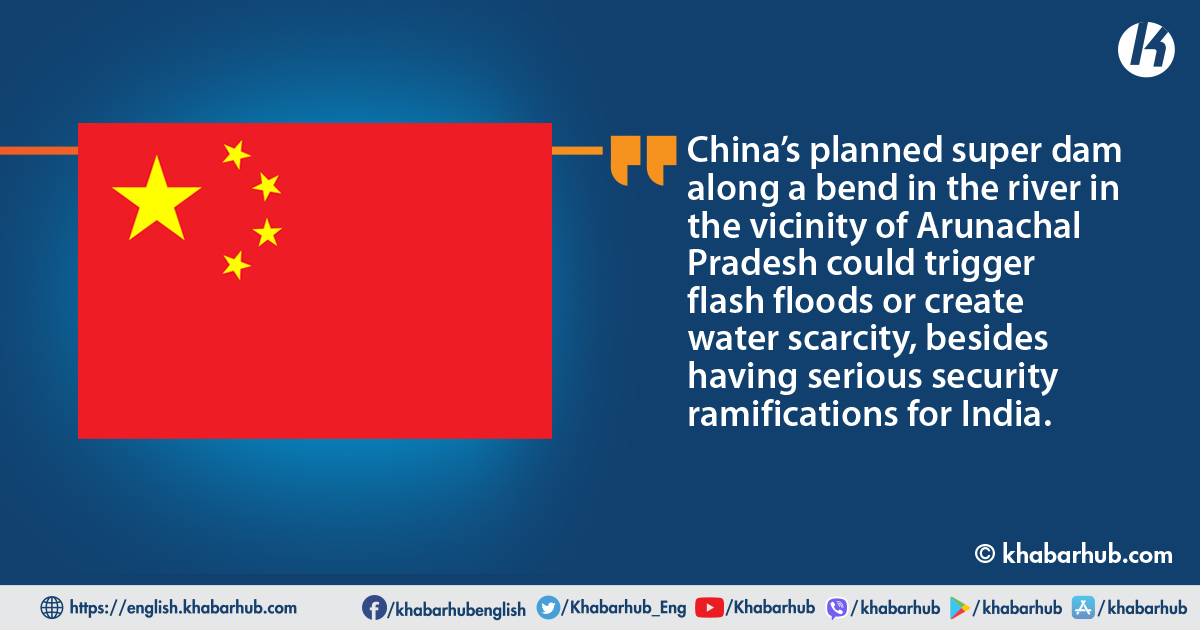China’s dams over major rivers like the Brahmaputra that flow into India and Bangladesh and the Mekong that flows into South East Asia have raised concerns in these downstream riparian countries over the potential of dams to trigger flash floods or create water scarcity, giving China strategic leverage.
The dams also pose a severe security risk for China’s neighbors as they give it a tool to manipulate the water flow of these rivers.
As the lowest riparian in the Brahmaputra, Bangladesh would be the most affected by dam activities undertaken by China.
The dams have the potential to disturb the flow of the river which is crucial for sustaining livelihoods and agriculture in the densely populated country.
According to statistics, at least 60% of Bangladesh’s population relies on the Brahmaputra’s catchment basin.
Any unilateral withdrawal of water by China can cause irreversible damage to its economy.
Exacerbated by climate changes, the mainstream dams present a danger to the fisheries and mangrove forests that depend upon the waters of Mekang River.
China’s planned super dam along a bend in the river in the vicinity of the Arunachal Pradesh could trigger flash floods or create water scarcity, besides having serious security ramifications for India.
Such a huge dam could hold back the massive amount of fertile soil being carried by the river, adversely affecting farming in the downstream areas.
Through these water-diversion projects on the Brahmaputra’s upper reaches, China could alter the river’s flow and course.
The proposed dams along the Brahmaputra also increases the mistrust between the two nations.
For example, China withheld the hydrological data from India during the Doklam standoff despite an existing hydrological data sharing agreement between them.
Along the Mekong River, extensive damming in China’s section has had the severest effects on downstream states especially Vietnam and Cambodia.
China has been accused by the South East Asian countries that a series of dams on the Mekong River had worsened water scarcities in downstream countries.
It has altered the flow of the water and impacted fisheries, agriculture, and biodiversity in the downstream riparian countries.
China can inflict economic damage on these countries with its control of the flow of water.
The economies of all the Mekong countries rely on the river. The Mekong’s floodplains and 37 wetlands sustain about 61 million people living in the five countries of Cambodia, Laos, Myanmar, Vietnam and Thailand.
While Laos largely depends on the Mekong as a source of electricity production, Cambodia, Laos and Thailand depend on it for fishing and Vietnam on the natural deposit of sediments for its rice crops and fishing.
The development activities in the Upper Mekong Basin have also challenged regional stability and the balance of power in the region.
The damming of the upper Mekong has been considered a geopolitical risk for the lower riparian states.
Some experts compare the downstream Mekong countries’ water security risk to China’s controversial island-building in the South China Sea.
In one instant, many cargo boats operating from Chiang Rai, Thailand’s main northern export hub to China, were left stranded due to low water levels caused by the sudden stoppage of flows by Chinese dams upstream.
In another instant, dozens of boats loaded with goods for China were left docked along the banks of the river between Myanmar and Laos due to shallow waters.
The five dams that China has promised to build as part of North Indus River Cascade in Pak occupied Kashmir have the potential to negatively affect the flow of water to lower riparian states, including India and Pakistan, especially in non-monsoon months and stop the flow of silt that supports agriculture downstream.
China can also sabotage the flow of these rivers by polluting them, rendering them unfit for use.
For example the Siang River, which joins the Lohit and the Dibang downstream to form the Brahmaputra, turned muddy and black in 2017 and became unfit for human consumption.
This severely affected agriculture production in the Siang Valley, the rice bowl of Arunachal Pradesh.
According to a report, hydropower dams on the Mekang River had a dramatic effect over the last two decades.
It resulted in unreasonable flooding and droughts, lower water and levels in the dry season and drops in the sediment which drastically impacted biodiversity and fisheries.
Mukunda Palat Rao of Columbia University’s Lamont-Doherty Earth Observatory, who investigated droughts and flooding in the Brahmaputra and Indus Rivers, also warned that the lower riparian countries should be prepared for a higher frequency of flooding in the Brahmaputra due to the construction of dams.
Exacerbated by climate changes, the mainstream dams present a danger to the fisheries and mangrove forests that depend upon the waters of Mekang River.
According to the International Panel on Climate Change, the Himalayan region is highly vulnerable to earthquakes and consequent natural disasters.
Hence, any increased construction of modern infrastructure projects (dams) is likely to put the whole region in grave peril.
Mukunda Palat Rao of Columbia University’s Lamont-Doherty Earth Observatory, who investigated droughts and flooding in the Brahmaputra and Indus Rivers, also warned that the lower riparian countries should be prepared for a higher frequency of flooding in the Brahmaputra due to the construction of dams.








Comment